TWH – Imagine for just a moment giving up life as you know it. You put your career on hold, sell most of your possessions, and move thousands of miles away to a remote world as foreign as anything could be. Scary? Exciting?
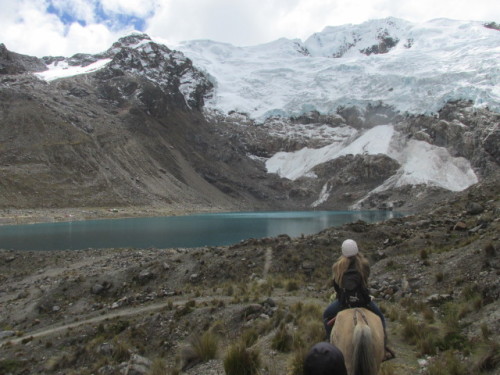
That is just what Alane Brown did. In the summer of 2012, she sold or gave away most her possessions, rented out her home, took a leave of absence from her job at Fort Lewis College and joined the Peace Corps. Alane was sent to Peru and has been living high in the Andes Mountains ever since. During this time she has taken Spanish language classes, struggled through cultural adjustments and adapted to the unique Peruvian climate situated in an entirely different hemisphere.Today she says, “I’m content, settled in, enjoying my life. And every day I wake up and I’m in Peru.”

Alane Brown
Prior to leaving Alane had a full life here in the Unites States. She is a social psychology professor with a PhD from Princeton University. Her research focused primarily on music and its effects on well-being. In addition, Alane is an accomplished musician who writes and performs with the Pagan group Crow Women. She is a Dianic Wiccan and a long-time member of Covenant of the Goddess.
In 2011 she and a friend began to entertain the possibility of joining the Peace Corps. Now in her 50s, Alane no longer had children “in the nest” or other similar responsibilities. She had the freedom to make the necessary sacrifices that would be required by such a commitment. She said:
I didn’t really think I’d go into the Peace Corps. [At first] it was more a way of supporting my friend… But as the process continued and I learned more about Peace Corps, I fell in love with it. I read a lot of volunteers’ blogs and I could picture myself in their lives. After a while, I became strongly committed….I wanted to do something different for a while, be someone different, live somewhere different.
On New Year’s Eve 2011 Alane submitted her online application. In June 2012, after what seemed like endless interviews, tests and examinations, she received a formal invitation to Peru.
#sthash.jhPlQtza.dpuf
Alane didn’t get to choose her assignment. The Peace Corps operates in over 70 countries and she could have been sent to any one of them. However, she was hoping for Peru. In fact, Alane molded her application in such a way that suggests she’d be a match for that territory. In 2012 she worked with llamas and began incorporating “Pachamama (the Peruvian Earth Mother)” into her magical work.
As the departure grew closer and the goodbyes were looming, Alane never had second thoughts. She recalls, “My energy was all in the direction of leaving. It wasn’t a hard decision.” The final two days were spent in Washington D.C. at Peace Corps orientation after which the staff put her and the other volunteers on a plane to their destinations. In September of 2012, Alane arrived in Peru.
For the first few months Alane lived and trained in the city of Chaclacayo. She took Spanish classes, cultural lessons and trained for her specific assignment – environmental clean-up, education and preservation. She said,
I learned how to build a tree nursery, what tree species to use for forestation in Peru and how to plant them, how to set up a recycling program, how solid waste management works, how protected areas work in Peru, how to teach environmental education in the school systems here etc.
After ten weeks of exhaustive training, Alane and the other volunteers were sent to their permanent locations. Alane recalls:
The staff could assign us to the desert coast, the lower mountains that are covered with jungle or the very high mountains of the Andes. On the day the assignments were revealed, the atmosphere in the training center was close to hysteria. They had us play a game that ended with us finding our assignments posted around the grounds of the center. I discovered that my assignment was Junin high in the central Andes.
Alane now lives with her host family in the small town of Marco. Her Peace Corps unit is currently the highest operating group at 11,000-13,000 feet above sea-level.
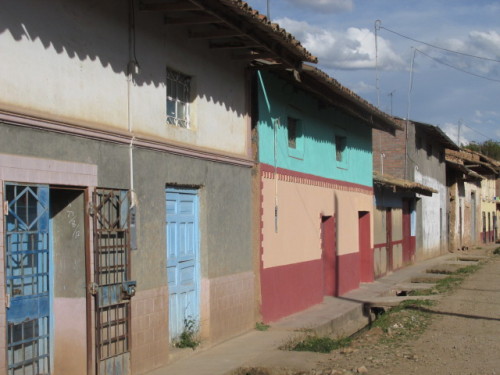
Alane’s Street in Marco
Living at that altitude has taken some adjustment and so has living in the southern hemisphere in general. The seasons are reversed. Alane has had to adjust her internal clock, so to speak, and being Pagan makes that adjustment a bit more challenging. She explains:
I’ve chosen to do the solstices and equinoxes according to the Southern Hemisphere. Right now it’s spring. But I do the cross-quarters in synch with the north, so I am heading toward Samhain. It’s kinda a screwy combination, but for me it honors the earth I walk on while keeping me in synch with my pagan community back home.
Aside from climate and language, Alane was confronted with hundreds of other challenges, some big and some small. These included things like “food, the slang, the way women are treated, the alcohol abuse…” She must take things day by day and reflects:
In a place like this, you can make plans, but things may or may not happen. A lot of the time I don’t really understand what’s going on, but I just have to hang in there and let things unfold. For a take-charge person like me, it’s a big lesson in letting go and letting things flow and accepting imperfection.
This is the first time that the Peace Corps has stationed volunteers in this specific area. Part of her project is to learn the customs and assess the willingness of the local people to work with the Peace Corps. Over the last ten months, Alane has gotten to know the villagers and their vibrant world.
This is Deep Peru. The older generation dress and live in the same way they have for hundreds of years. The town is a sea of handmade adobe buildings capped with Spanish tile, although cement is making its incursion. The main traffic on most of the roads is people taking their cows, sheep and burros out to graze in the fields.
Most of the people are Catholic with both Spanish and indigenous ancestry. Their modern culture is a blend of European and folk customs.
There is a growing movement to honor and preserve Andean cosmology. I think that’s why it’s been so easy for me to find the ‘pagan’ community here. Activists are reclaiming these spiritual traditions. There are ceremonies, conferences, and spiritual centers springing up.
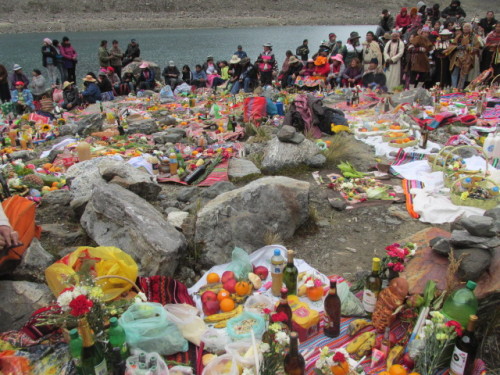
Winter Solstice Ceremony
On her blog Alane recounts a beautiful Winter Solstice experience. She says “This is where I am, so I honor this land by respectfully participating in the spirituality of this place.” A few weeks ago she participated in a Spring Equinox ritual. She recalls,
We lit a small fire of palo santo (an aromatic wood). We offered a drink called chica to the Pachamama and shared the cup around the circle. Everyone said what was in their hearts. I offered the greetings of the eagle of the north to the people of the condor and asked the blessings of the Pachamama on our environmental projects in the Yanamarca Valley.
She then remarks “it was so beautiful my chest hurt,” adding:
This valley specializes in music and traditional dances. It is very common that there’s a holiday that involves a procession in traditional clothing and masks with at least one orchestra playing. I get pulled into dances and handed beer to share.
Alane will be spending another fourteen months working and living in the region – another fourteen months of being pulled into dances and sharing libations. When not in celebration, Alane and the other Peace Corps volunteers will be helping locals clean-up the environment and establish a functional eco-tourism industry with geo-caching. Why? She explains:
The idea is that tourism development motivates preservation of natural resources and environmental activism. It is already working. For example, the prospect of bringing in tourists has motivated trash cleanup projects and has revitalized reforestation.
This revitalization project is funded primarily by the local Peruvian governments but they need an “infusion of cash to get the project off the ground.” Alane has set up two website sites (listed below) to share her work and illustrate the need for donations. Her friends and family in New Mexico have already donated over 700 dollars – about ¼ of the funds needed to finish the project.
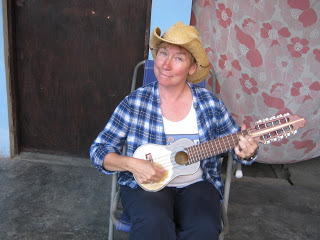
With all this education, personal growth and environmental work, Alane appears to be taking in far more than she ever dreamed. It is the so-called “adventure of a lifetime.” However, there is one other piece of the story that has yet to be been mentioned.That piece is music.
As Alane lives through this journey, her fans will benefit from the inspiration she finds high within the Andes Mountains as it settles deep within the rhythms of her new songs. So far she has written two songs and her favorite is Somos la Luna Nueva (We are the New Moon). It was recorded on a hand-held device and sent it to Crow Women who will be performing it this fall. By the end of her trip Alane hopes to have enough material for at least one full album. She says:
I’m experiencing the days, being awake, savoring as much as possible…I’m donating two years of my life to Peru. If everyone took a few years out of a lifetime to live in another country, really in the country, as part of the community, helping the community to meet the goals it has set for itself, well, that would bring us closer to world peace.
To continuing following Alane on her journey, donate to her project or find out more about joining the Peace Corps, go to her websites: Blog Pachamama or at tourism site Keteka.
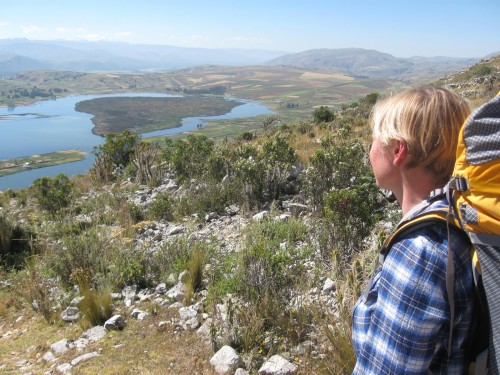
The Wild Hunt is not responsible for links to external content.
To join a conversation on this post:
Visit our The Wild Hunt subreddit! Point your favorite browser to https://www.reddit.com/r/The_Wild_Hunt_News/, then click “JOIN”. Make sure to click the bell, too, to be notified of new articles posted to our subreddit.
What an amazing journey and story. Such an inspiration!
Kudos to Alane! This kind of engagement with our living world and its peoples that makes me proud to be Pagan. I want to tell my interfaith colleagues about Alane’s work.